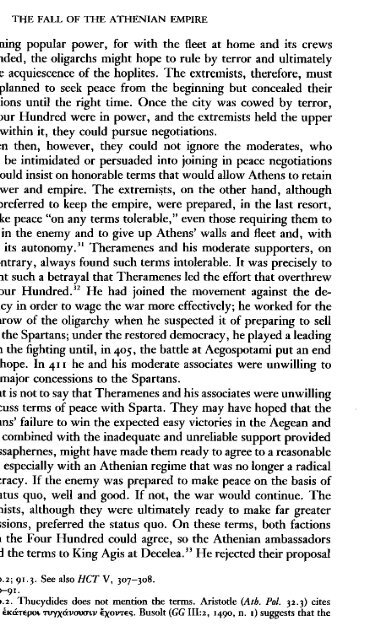The Fall of the Athenian Empire-(A New History of the Peloponnesian War) Donald Kagan - (1987)
MACEDONIA is GREECE and will always be GREECE- (if they are desperate to steal a name, Monkeydonkeys suits them just fine) ΚΑΤΩ Η ΣΥΓΚΥΒΕΡΝΗΣΗ ΤΩΝ ΠΡΟΔΟΤΩΝ!!! Strabo – “Geography” “There remain of Europe, first, Macedonia and the parts of Thrace that are contiguous to it and extend as far as Byzantium; secondly, Greece; and thirdly, the islands that are close by. Macedonia, of course, is a part of Greece, yet now, since I am following the nature and shape of the places geographically, I have decided to classify it apart from the rest of Greece and to join it with that part of Thrace which borders on it and extends as far as the mouth of the Euxine and the Propontis. Then, a little further on, Strabo mentions Cypsela and the Hebrus River, and also describes a sort of parallelogram in which the whole of Macedonia lies.” (Strab. 7.fragments.9) ΚΚΕ, ΚΝΕ, ΟΝΝΕΔ, ΑΓΟΡΑ,ΕΚΚΛΗΣΙΑ,ΝΕΑ,ΦΩΝΗ,ΦΕΚ,ΝΟΜΟΣ,LIFO,MACEDONIA, ALEXANDER, GREECE,IKEA
MACEDONIA is GREECE and will always be GREECE- (if they are desperate to steal a name, Monkeydonkeys suits them just fine)
ΚΑΤΩ Η ΣΥΓΚΥΒΕΡΝΗΣΗ ΤΩΝ ΠΡΟΔΟΤΩΝ!!!
Strabo – “Geography”
“There remain of Europe, first, Macedonia and the parts of Thrace that are contiguous to it and extend as far as Byzantium; secondly, Greece; and thirdly, the islands that are close by. Macedonia, of course, is a part of Greece, yet now, since I am following the nature and shape of the places geographically, I have decided to classify it apart from the rest of Greece and to join it with that part of Thrace which borders on it and extends as far as the mouth of the Euxine and the Propontis. Then, a little further on, Strabo mentions Cypsela and the Hebrus River, and also describes a sort of parallelogram in which the whole of Macedonia lies.”
(Strab. 7.fragments.9)
ΚΚΕ, ΚΝΕ, ΟΝΝΕΔ, ΑΓΟΡΑ,ΕΚΚΛΗΣΙΑ,ΝΕΑ,ΦΩΝΗ,ΦΕΚ,ΝΟΜΟΣ,LIFO,MACEDONIA, ALEXANDER, GREECE,IKEA
You also want an ePaper? Increase the reach of your titles
YUMPU automatically turns print PDFs into web optimized ePapers that Google loves.
I68<br />
THE FALL OF THE ATHENIAN EMPIRE<br />
victory at A<strong>the</strong>ns was not at hand and that serious negotiations might<br />
be desirable, but any hope that <strong>the</strong> Four Hundred could easily make<br />
peace depended on <strong>the</strong> unlikely possibility that <strong>the</strong> government at<br />
Sparta would be willing to accept <strong>the</strong> terms so swiftly rejected by<br />
Agis.<br />
Not long after <strong>the</strong> skirmish with Agis' army, <strong>the</strong> Four Hundred<br />
turned to <strong>the</strong> problem <strong>of</strong> relations with <strong>the</strong> A<strong>the</strong>nian forces on Samos. 39<br />
<strong>The</strong> plot to overthrow <strong>the</strong> A<strong>the</strong>nian democracy had originated <strong>the</strong>re<br />
and included a design to establish an oligarchy on Samos as well, but<br />
things had not gone according to plan. Even before <strong>the</strong> coup in A<strong>the</strong>ns,<br />
perhaps in March <strong>of</strong> 4 I I, Peisander had persuaded some <strong>of</strong> <strong>the</strong> leading<br />
men on Samos to try to set up an oligarchy on <strong>the</strong> island."" <strong>The</strong>se men<br />
had taken part in <strong>the</strong> democratic revolution <strong>of</strong> <strong>the</strong> previous year, but<br />
now Peisander was able to convince <strong>the</strong>m to change sides. <strong>The</strong>y formed<br />
<strong>the</strong>mselves into a conspiracy <strong>of</strong> Three Hundred, took a common oath,<br />
and planned an attack on <strong>the</strong>ir former collaborators in <strong>the</strong> democratic<br />
faction that ruled Samos. It would be interesting to know why <strong>the</strong>y<br />
were willing to turn against <strong>the</strong> new Samian democracy so soon after<br />
<strong>the</strong>y had taken part in its establishment, but nei<strong>the</strong>r Thucydides nor<br />
any o<strong>the</strong>r ancient writer tells us. Perhaps <strong>the</strong>y merely sought to increase<br />
<strong>the</strong>ir own power and advantage within <strong>the</strong> Samian ruling group,<br />
or perhaps <strong>the</strong>y judged that <strong>the</strong> future <strong>of</strong> A<strong>the</strong>ns lay witli <strong>the</strong> oligarchs<br />
and wanted to gain favor and advantage by joining <strong>the</strong>m." In any<br />
case, <strong>the</strong>y proceeded in <strong>the</strong> same way as <strong>the</strong> oligarchic conspirators at<br />
A<strong>the</strong>ns: by means <strong>of</strong> terror. Acting in concert with <strong>the</strong> general Charminus<br />
and o<strong>the</strong>r A<strong>the</strong>nian oligarchs on Samos, <strong>the</strong>y murdered Hyperbolus,<br />
who had lived on <strong>the</strong> island since his ostracism in 4I6. <strong>The</strong><br />
infamous A<strong>the</strong>nian demagogue must have had some prominent place<br />
in <strong>the</strong> democratic movement on Samos, because Thucydides says that<br />
<strong>the</strong> Samian Three Hundred regarded <strong>the</strong>ir role in <strong>the</strong> assassination as<br />
"giving a pledge <strong>of</strong> good faith" to <strong>the</strong> A<strong>the</strong>nian oligarchs!'<br />
This was only one <strong>of</strong> several similar acts, but instead <strong>of</strong> paralyzing<br />
<strong>the</strong>ir opponents with fear, <strong>the</strong>se acts <strong>of</strong> terror alerted <strong>the</strong>m to <strong>the</strong> danger<br />
and moved <strong>the</strong>m to defend <strong>the</strong>mselves. <strong>The</strong> Samian democrats went<br />
for help to those A<strong>the</strong>nians whom <strong>the</strong>y trusted above all o<strong>the</strong>rs to be<br />
l 9 8.72.1-2. For <strong>the</strong> timing <strong>of</strong> <strong>the</strong>ir action, see 86.3; and HCT V, 184, 285.<br />
40<br />
8.6J.J; 73·2-J. For <strong>the</strong> date, see HCT V, 154.<br />
41<br />
For a discussion <strong>of</strong> <strong>the</strong> motives <strong>of</strong> <strong>the</strong> Samian Three Hundred, seeR. P. Legon,<br />
Historia XXI (1972), 156.<br />
428·73·3·

















